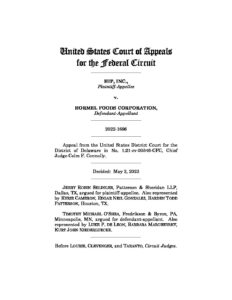By Salim A. Hasan
The Federal Circuit recently decided that an alleged inventor’s contribution to a patent claim was “insignificant in quality” and thus did not meet the standard for joint inventorship. Hip, Inc. v. Hormel Foods Corporation, No. 2022-1696 (Fed. Cir. May 2, 2023)
The patent at issue was U.S. Patent 9,980,498, owned by Hormel (“the Hormel patent”). The Hormel patent involves a two-step process for making meat such as bacon. The process involves preheating meat pieces followed by cooking the meat in a higher-temperature steam oven. The preheating step creates a layer of melted fat around the meat pieces, which protects the meat from condensation that may wash away salt and flavor during the cooking process. The second step prevents the charred, so-called “off” flavor associated with cooking the meat pieces at higher temperatures.
Independent claims 1 and 5 were considered relevant on appeal. Claim 1 involves preheating bacon pieces with a microwave oven. Claim 5 recites preheating meat using a microwave oven or an infrared oven.
The Hormel patent names four employees of Hormel as inventors. HIP, formerly known as Unitherm Food Systems, filed suit in the Delaware District Court seeking to correct the inventorship and ownership of the Hormel patent. The basis of the suit was that Hormel had met with David Howard of Unitherm in 2007 to work on a joint project to develop a cooking process. HIP alleged that Howard disclosed the infrared preheating concept at issue on appeal. The district court determined in favor of HIP, ruling that Howard was a co-inventor because he contributed the preheating with an infrared oven concept in independent claim 5. The Federal Circuit reversed.
While the patent statute recognizes that an invention may be jointly invented, there is no express definition for joint inventorship in the statute. As a result, courts must determine what constitutes sufficient contribution to meet the standard for being a co-inventor. Under Pannu v. Iolab Corp., 155 F.3d 1344 (Fed. Cir. 1998), to be a joint inventor, one must:
- contribute in some significant manner to the conception or reduction to practice of the invention;
- make a contribution to the claimed invention that is not insignificant in quality, when that contribution is measured against the dimension of the full invention; and
- do more than merely explain to the real inventors well-known concepts and/or the current state of the art.
The Federal Circuit decided that Howard failed to meet the second Pannu factor because the alleged contribution of preheating meat pieces using an infrared oven was “insignificant in quality.” In so ruling, the Court found that the specification mentions preheating with an infrared oven only once. The Court also pointed out that only claim 5 mentions the infrared oven and even then merely as part of a Markush grouping. In addition, the Court noted that the other independent claims recite precooking using a microwave oven. The Court went on to compare the amount of disclosure provided for microwave ovens, which was far more substantial.
This case illustrates the importance of the amount of disclosure for a claimed feature relied upon for joint inventorship. In determining whether contribution of a particular feature rises to the level of co-inventorship, the analysis may hinge on the amount of disclosure provided in the specification relative to the invention as a whole. Applicants should be mindful regarding how much disclosure is provided in the specification regarding a particular feature being relied upon for inventive contribution.


